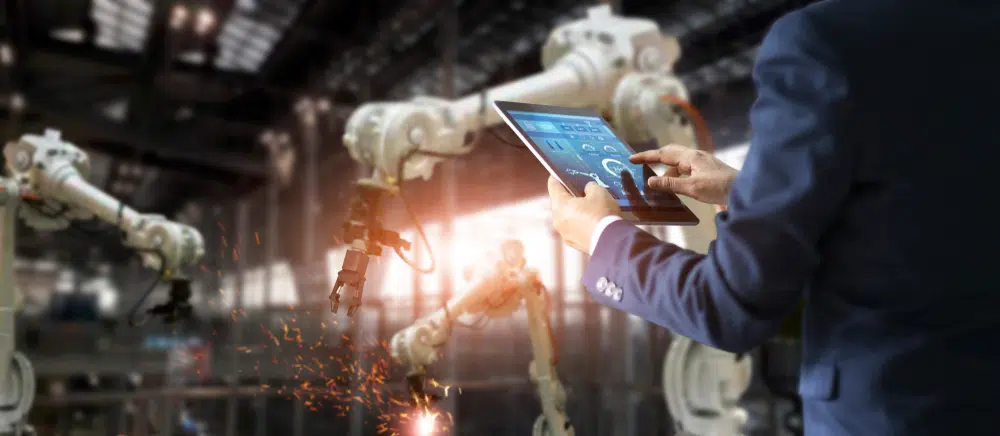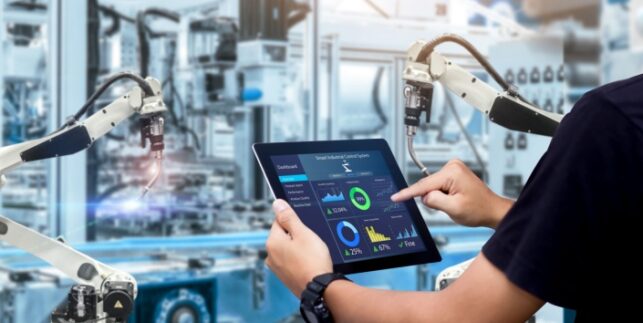The Modern Smart Factory – What Does It Mean for Manufacturers?

The staggering increase in computing power, methods, and technology over the past decade has become the basis for a major revolution in manufacturing. Many manufacturers are moving towards the smart factory model, doing everything they can to leverage new technologies on the factory floor. But what exactly is a smart factory, and what does it have to offer for modern manufacturers?
The Onset of the Fourth Industrial Revolution
Industry 4.0 is an ongoing transition that is affecting operations across all industries, not just manufacturing. It’s called Industry 4.0 because it represents a fourth industrial revolution after the first three changed the world over the last few centuries through the adoption of steam power, electricity, and digital technology. Today, new technology and processes are driving the Industry 4.0 revolution through a process called digitalization.
While manufacturing has relied on computing power for decades, with examples like PLCs dating back to the 1960s, the synergy and efficiency that are being achieved through digitalization is something different entirely. With greater monitoring, automation, connectivity, and even AI-driven analysis capabilities, the factory floor has entered a new era.
Smart Factories Bring Industry 4.0 to the Factor Floor
Within manufacturing, we can see the advancements of Industry 4.0 most clearly on the factory floor. The smart factory is a factory that makes the best use of available solutions to achieve faster response times, decreased energy and material consumption, greater flexibility, and more.
How organizations can best implement the smart factory model is by no means set in stone, with constant advancements providing more opportunities for improvement. Many organizations use the McKinsey digital compass to identify areas where digitalization could provide value, focusing on the areas of:
- Resources and processing
- Asset utilization
- Labor
- Inventories
- Quality control
- Supply and demand
- Time to market
- Service and aftersales
These broad categories cover many different aspects of the overall manufacturing process. While some are being driven by innovations in manufacturing technology directly, most are being improved through the better collection, analysis, understanding, and application of data. By leveraging this data more effectively, manufacturers can achieve a more agile factory floor.
Smart Factories Reduce Reaction Time – Saving Both Time and Money
A smart factory is a factory that is more agile, that is able to identify and resolve issues more quickly. More specifically, they reduce the latency between the steps that go into solving any problem on the factory floor. While each step will still take time to carry out, a smart factory implements monitoring, communication, and analysis to eliminate any wasted time at these key points.
1. Event to Visibility
The time between some event or issue arising and someone noticing the problem can be one of the most significant sources of waste for manufacturers. In conventional factories, many upsets can go undetected for long periods of time.
If there is a slight increase in resource consumption or a slight decrease in quality, it might not be recognized for many production runs. Larger deviations can still lead to significant waste if they can only be identified after a specific shift or run is completed. The smaller any deviation from set standards is, the longer it’s likely to go unnoticed and lead to similar losses compared to larger issues that are identified more quickly.
A smart factory solves this problem through active monitoring and real-time oversight. Instead of relying on tallies at the ends of shifts, a smart factory can keep a continuous record of key performance indicators (KPIs) and other metrics. When performance or quality drops, a smart factory can let the production team know immediately, cutting the latency between event and visibility to practically zero.
2. Visibility to Analysis
Now that the production team knows that something is wrong, they need to analyze the situation in order to come up with a solution. To develop a solution, they’re going to need to be able to close in on the root cause behind the issue. Doing so requires accurate, real-time information. A smart factory makes it easy for the production team to access this information as quickly as possible.
But that’s far from the only way that a smart factory can provide faster analysis. In many cases, the required solution will involve an adjustment to work order scheduling. On factory floors with many steps and many individual machines, making effective changes can be far too complicated to do manually. A smart factory can automate this optimization, ensuring that processes continue to achieve the highest possible performance in any scenario.
3. Analysis to Action
Once a possible solution has been developed, the production team has to put that solution into action. There are a wide variety of tasks that any solution might require, from having a technician perform maintenance on a machine to adjusting the levels of ingredients and additives in a certain recipe. In any case, effective communication is the key to putting the solution into action as quickly as possible.
Smart factories will have the necessary process control automation to make adjustments quickly. This means that they’ll be able to do so through the same platform or dashboard that they used to identify the problem in the first place. A smart factory has all of these key functions available through a unified solution, rather than relying on operators to switch between multiple systems.
This also includes human-to-human communications. A smart factory will have a communications solution in place that allows managers to immediately communicate with any individuals who are needed to resolve the issue, calling them into action without any unnecessary delays.
4. Action to Results
A vital part of any solution is being able to determine if it has effectively resolved the issue. Smart factories greatly expedite this process through the same real-time visibility that allowed the problem to be identified in the first place. Production teams will be able to see the immediate impact on KPIs and other metrics, rather than having to wait for an entire production run to be completed to get those numbers.

Changing the way people work in factories
Request a DemoMaking Your Factory Smarter With Matics
Matics provides a versatile real-time operational intelligence (RtOI) solution that can play a vital role in transforming your operation into a smart factory. Our solution incorporates the real-time visibility, analysis, and communication that you need to identify and resolve changes in your production environment as quickly as possible.
Our system aggregates data from the machines on your factory floor, your existing enterprise resource planning (ERP) system, and any other available sources to provide you with an instantaneous overview of your factory. We create a kind of digital twin for each machine, which lets you evaluate KPIs, view production history, and review communications regarding that specific machine, all of which let you resolve issues more quickly.
The Matics solution provides automated alerts whenever your process goes outside your set limits. These alerts are directed to the appropriate individuals to resolve the issue, providing them with the necessary context to act immediately. Our system takes your factors through the event, visibility, analysis, action, and results faster, reducing waste and mitigating costs.
You can reach out to the team at Matics today to book a demo and hear more about what our solution can do for your factory.




